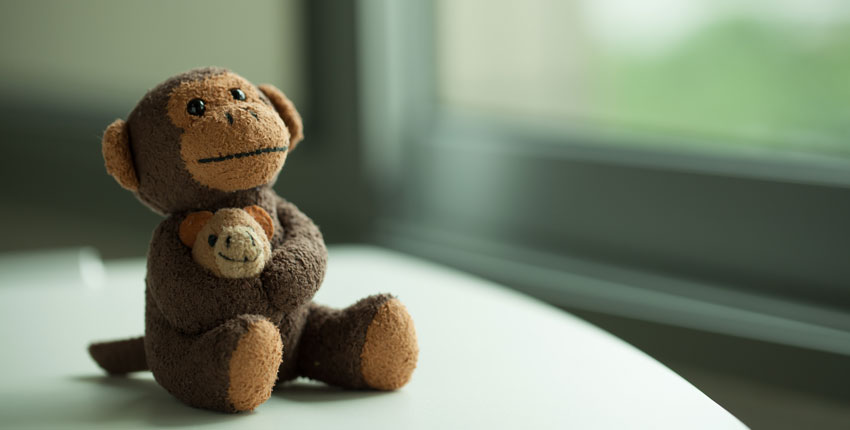
Neurobiologist Margaret Livingstone never expected to publish a study on maternal attachment and bonding in monkeys. However, in the course of her research on how visual object recognition develops in infant macaques, she made a series of surprising observations about their mothers, and she knew she had to share it.
In a new paper, Livingstone describes eight observations of five macaque mothers over 10 years. The study, published Sep. 19 in PNAS, reveals that mothers who had recently given birth could bond with a stuffed toy in a manner similar to how macaque mothers typically bond with their actual infants. The observations suggest that monkey mothers form attachments to infants based on the tactile sensation of soft texture rather than on other cues, including sight and sound.
Thought-provoking content
In-depth stories on science and medicine
The research builds on foundational studies from the mid-1900s on the biological basis for how infants bond with their mothers. However, the new paper focuses on the maternal side of bonding, which remains understudied and poorly understood. Broadly, the findings provide new insights about the role of touch in mother–infant bonding in macaques and, potentially, in humans.
Livingstone, the Takeda Professor of Neurobiology in the Blavatnik Institute at Harvard Medical School, spoke with Harvard Medicine News about the history of our understanding of attachment, what her observations reveal about maternal bonding, and why studying monkeys is essential for learning about complex human cognition.
HMNews: How did you end up studying maternal attachment and bonding in macaques?
Livingstone: I actually don’t study animal behavior. The main thrust of my lab is studying vision, in particular the inferior temporal cortex of the brain, which is a region important for object recognition. The visual system is made up of a series of hierarchical levels that lead to our very sophisticated object-recognition abilities. The highest levels in the visual hierarchy have specialized domains that code for important objects like faces and bodies. Both monkey and human brains have this feature, so we began studying macaques as a way of elucidating how object recognition works in humans. Our monkeys are socially housed and sometimes get pregnant. Over 10 years, I made a series of unexpected, incidental observations about how monkey mothers form attachments to their infants. This paper is the result of these observations.
HMNews: In the paper, you discuss how our understanding of attachment has evolved. Can you expand on that?
Livingstone: In the first half of the 1900s, there was widespread adoption of behaviorism in raising children, which is the idea that children should be raised in a clean, sterile environment using scientific principles of conditioning and training. As a result, parents were told that too much love and physical affection towards children was bad, and that babies learned to love their mothers only because they provide milk. In fact, the behaviorist John Watson, who invented the term behaviorism, wrote a parenting book that outlined ‘the dangers of too much mother love.’ Among other things, the book instructed parents to be objective and firm, and to never hug and kiss children. It was severe.
This idea influenced how children were treated during this period. Orphanages often isolated children, especially ones who weren’t thriving, to prevent the spread of germs. In hospitals, parents could not visit premature babies or sick children due to fear of spreading infection. Behaviorist B.F. Skinner raised his own daughter in a cubicle. Even my grandfather in the 1950s was convinced that my mother shouldn’t pick me up when I wanted to be held. In the mid-1900s, however, studies started coming out documenting psychological problems in children who had been raised in institutions under isolating conditions. Back then, the behaviorists argued that these problems were due to genetics or socioeconomic status, not lack of nurturing.
HMNews: This is not how most people seem to approach parenting now. Why did behaviorism fall out of favor?
Livingstone: The thinking began to change for two reasons. The first was growing evidence on the effects of isolation on children. The second was the work of the psychologist Harry Harlow with infant macaques. He had started out by trying to figure out how to raise newborn macaques separately from their mothers in order to reduce the disease burden in his monkey colony. He discovered that the infant monkeys formed strong attachments to soft towels, and they were upset when the towels were taken away. The infant monkeys raised with a soft towel were larger and healthier than those raised by their own mothers. Harlow and his colleagues then did a series of experiments to better understand this phenomenon. They found that infant monkeys universally preferred soft surrogates over hard surrogates, even when the hard surrogates had a face or provided milk or heat. The infant monkeys were just as attached to the soft surrogates as other infant monkeys were to their actual mothers. Those who didn’t have a soft surrogate failed to thrive and developed behavioral issues. Harlow’s research showed that attachment in infant monkeys is mostly tactile, and bonding with a soft object happens relatively quickly.
Harlow’s work and the studies on children raised in isolation made people realize the importance of physical touch in child-rearing and that isolation was terrible for young children. By 1950, this new approach had taken over. Harlow’s research on infant macaques made a huge difference in the way we raise children. However, there has been very little research on the maternal side of attachment, which is what my new paper addresses.
HMNews: What did you observe about attachment and bonding in macaque mothers?
Livingstone: I love this paper because I did not expect the results — they were a total surprise. I made the first observation back in 2013, when, sadly, our macaque Venus gave birth to a stillborn infant. I called the vets, and they told me I had to remove the dead infant for the mother’s health. When I did, she became distressed, so I thought, maybe I could calm her down if I gave her one of the stuffed toys I keep in my office for the infants. I offered her a stuffed mouse, and she immediately grabbed it from me and calmed down. I came in the next day, and she was still calm and holding the stuffed toy. It was amazing. After that, every time we had to take an infant away from a mother for our research on cognitive development, we offered the mother a stuffed toy. We did this many times over the years, and we never had another distressed mother after that. We noticed that about half of the mothers adopted the stuffed animals, and the other half didn’t seem to care.
Of the observations we included in the paper, three of the mothers, who gave birth to five babies at different points over the years, picked up a stuffed toy and carried it around for weeks to months. Once they identified the stuffed animal as their attachment target, they mostly held it to their chest, occasionally looking at it or grooming it. One of the mothers chose a stuffed animal over a hard, pink baby doll offered at the same time, and another picked the stuffed animal over a hard Kong toy. The other two females showed no distress at the absence of their infants, and they did not pick up the stuffed animals. In one astonishing case, a mother who had been holding a stuffed toy continuously since the morning of birth chose to continue carrying the toy around, even when we tried to return her own infant to her later in the day. She preferred the stuffed animal. That observation is what prompted me to write this paper.
HMNews: Why were these observations so surprising? What do they tell us about maternal attachment?
Livingstone: Like humans, monkeys have a sophisticated social structure and a complicated visual system with specialized regions selective for faces and bodies. In fact, a third of the macaque brain is visual. We knew from our earlier research that monkeys must be exposed to faces during their early development in order to form domains for facial recognition. However, this process has already happened in adult monkeys. Monkeys recognize each other; they know which individuals they like and don’t like. They can even distinguish between different humans. Adult monkeys clearly recognize faces, and they convey a lot of important information to each other with their faces.
Therefore, we assumed that mothers would have a template for what a baby monkey ought to look like. But as it turns out, they don’t. It seems like the monkeys don’t use vision to recognize their own babies, but instead initially bond with the newborns based on touch. Analogous to imprinting in baby birds, female monkeys appear to bond with the first soft thing they encounter after giving birth, and they consider it to be their baby. Eventually, the mothers doubtless develop a complicated, high-level, multisensory template for recognizing their baby, but the initial trigger for forming that bond seems to be tactile.
In retrospect, this makes sense. Maternal bonding evolved much earlier than the higher visual areas in temporal cortex, so mammals must have evolved a way of bonding with their babies that doesn’t rely on this visual region of the brain. They have this simple trigger for bonding based on touch that usually works fine given the proximity of the baby after birth. Additionally, this very low-level template could continue to be used for maternal bonding even as the physical form of monkeys — including the appearance of their faces and bodies — evolved over time. What we found also aligns with Harlow’s conclusion that infant monkeys form attachments to soft objects based on touch.
HMNews: What is the broader significance of these findings? Do they have any relevance for humans?
Because of the similarities between monkey and human brains, I wouldn’t be surprised if touch and soft texture also play an important role in the bonding of human mothers with their babies, or even in other kinds of human attachments. I don’t think we’ve given enough credit to these low-level inputs into our subconscious, and I wonder about the therapeutic usefulness of touch in humans. We think we’re too fancy and sophisticated for things like touch to matter, but I bet it does. Touch may be a lot more important than we give it credit for, especially in a hormonally primed situation like giving birth. For example, I’ve been reading that sometimes women who have miscarriages are comforted by lifelike baby dolls. I wonder if stuffed toys, or pets, could also be therapeutic. Maybe there are potential therapies based on touch and soft texture for women who lose babies, or even for people who are depressed. Maybe an attachment drive for touch is why pets are so popular.
HMNews: Why do research with monkeys at all?
Livingstone: First, it is a privilege to work with macaques. We take great care to treat them well, to raise them in comfortable, enriched environments with a lot of nurturing care. For example, we give the infants Baby Einstein toys and stuffed toys to play with and hold, and, being a morning person, I am the one who does the early-morning bottle feedings. Indeed, Venus is the background image on my phone.
The reason we study macaques is because really, they’re just like us. Their brains are very similar to ours. We can’t learn about things like high-level visual processing or cognition from rats or mice because this kind of processing doesn’t occur in rodent brains. We have to study nonhuman primates in order to understand complex cognition and how our human brains develop into what they are.
Our research on baby monkeys provides valuable information about what is happening in the human brain during early development. For example, we’ve learned that if a monkey doesn’t see faces in its first year of life, which is equivalent to the first four or five years of a child’s life, then it will never have normal facial and social recognition. Understanding how and why various experiences are important for normal development is key. This gives us insights into the kinds of experiences necessary for proper brain development at various stages of infancy and childhood. It also tells us what abnormal early experiences might result in permanent visual, social, or cognitive deficits.
My laboratory was previously run by David Hubel and Torsten Wiesel, who also studied monkeys. One of the things they discovered is that if a monkey’s vision in one eye is blocked, for example, by a cataract, for even a few months during early development, that eye loses its connections to the brain, resulting in permanent blindness. However, the same is not true in adults, since the connections are solidified and no longer malleable. Adults can have a cataract for years, and as soon as it’s treated, they see fine. As a direct result of their research, physicians began doing surgery on children with cataracts or misaligned eyes within a few months after birth rather than waiting several years. Earlier surgery dramatically improved outcomes in children.
In the same way, I think that object recognition, and even higher-level cognitive processes, may have early critical periods of plasticity: windows of opportunity that close over time. We need to study monkeys to understand how these processes work during human development and how we can intervene when a child suffers abnormal early experiences or doesn’t develop as expected.
To circle back to Harlow, his work with monkeys illuminated touch and attachment as the foundation for healthy childhood development. These findings led to widespread changes in how children were treated. Although the direct application may not necessarily be clear from the outset, we do research on monkeys with the ultimate goal of deepening our understanding of human brains and behavior so we can eventually benefit human society in some way.





